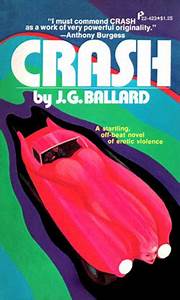 By J.G. BALLARD (Pinnacle; 1973)
By J.G. BALLARD (Pinnacle; 1973)
There’s never been another novel like this one, and that includes those of its author, the brilliant James Graham Ballard. CRASH was adapted from a short piece that initially appeared in Ballard’s ATROCITY EXHIBITION (1969). That singularly bizarre novel was presented as a faux-scientific text detailing a mental breakdown that incorporates the creation of car accident exhibitions, irreverent reconceptualizations of the assassination of JFK, and perverted scenarios about the deaths of Jacqueline Kennedy and Ronald Reagan.
CRASH is in many respects the most radical and innovative of all Ballard’s novels. Unlike THE ATROCITY EXHIBITION, it’s taut, sustained and quite readable—yet just as relentlessly clinical and surreal. Make no mistake: CRASH is a frankly pornographic novel with sexual descriptions as graphic as any you’re likely to find, yet the nexus of its eroticism–the car crash as harbinger of a new sexuality—definitely puts it in a category of its own. If there’s a better fictional depiction of the dangerous interplay of sex and technology I have yet to read it.
“Did the odor of illicit sex acts infest (the nurses’) underwear as they drove home from the hospital, the traces of smegma and vaginal mucus on their hands marrying with the splashed engine coolant of unexpected car crashes?” “Already the skin picked in a palisade of notches from her lower lip marked the arithmetic of widowhood…” “I wanted to adjust the contours of her breasts and hips to the roofline of the car, celebrating in this sexual act the marriage of their bodies with this benign technology.” Only J.G. Ballard could conjure up such maniacally inventive verbiage, which can easily become overwrought and/or a parody of itself (see Ballard’s later novels HELLO AMERICA and RUSHING TO PARADISE) but arguably reaches its full expression in CRASH.
The plot, such as it is, begins with the narrator, appropriately named James Ballard, surviving a car accident that claims the life of a prominent doctor. Finding himself unhealthily obsessed by the sexually-tinged violence of the crash, Ballard commences an affair with the deceased doctor’s widow Helen, while Ballard’s hot-to-trot wife Catherine grows quite turned on by the gory details of her husband’s accident. Then there’s the “Degenerate Scientist” Vaughan, a charismatic freak who corrals a loose coalition of accident victims obsessed with the erotic potential of the car crash. It’s Vaughan who brings James, Helen and Catherine together by drawing them inexorably into his psychotic vortex, colored by Vaughan’s all-consuming longing to die in a head-on collision with Elizabeth Taylor.
Highlights include an encounter with two whores, prefaced by Vaughan admonishing one of them to spit out her gum, as “I don’t want you blowing it up my urethra”; Ballard’s gruesome copulation with a crippled woman’s leg wounds; a freeway acid trip containing some truly mind-scraping psychedelic imagery (“The marker lines diving and turning formed a maze of white snakes, writhing as they carried the wheels of the cars crossing their backs”); and the climax, which finds Ballard and Vaughan engaged in minutely described backseat copulation (which probably seemed far more shocking back in 1973 than it does today).
Obviously these events can be interpreted in any number of ways. Ballard himself claims the novel is primarily concerned with the “Death of Affect” (i.e. a deadening of emotional response) and the automobile as a metaphor for late 20th Century existence. Those things probably come through better in the David Cronenberg film adaptation, which is cold and clinical to a fault. This novel, by contrast, has an exhilarating audacity and imaginative richness that nearly override the weirdness and grotesquerie, and fully embody Ballard’s famous credo that “I believe in the death of the emotions and the triumph of the imagination.”
